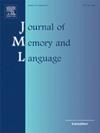The phonology of letter shapes: Feature economy and informativeness in 43 writing systems
IF 2.9
1区 心理学
Q1 LINGUISTICS
引用次数: 0
Abstract
Differentiating letter shapes accurately is a core competence for any reader. Are letter shapes as distinctive as they could be? The visual shapes of letters, contrary to the phonemes of spoken languages, lack a unified description — an equivalent of the phonological features that describe most phonemes in the world’s languages. Using a gamified crowdsourcing approach, we elicited thousands of letter descriptions from lay people for the sets of letter shapes (the scripts) used in 43 diverse writing systems. Using 19,591 letter classifications, contributed by 1,683 participants, who were asked to sort the letters of each script repeatedly into two groups, we extracted a sufficient number of binary classifications (features) to provide a unique description for all letters in the 43 scripts. We show that scripts, compared to phoneme inventories, use more features to produce similar sets of distinct elements. Compared to the phoneme inventories of a large sample of the world’s languages dataset (the P-base dataset, collected by another team), our 43 scripts have lower feature economy (fewer symbols for a given number of features) and lower feature informativeness (a less balanced distribution of feature values). Compared to phonemes, letter shapes require more binary features for a complete description. These features are also less informative in letters than in phonemes: the chances that two random letters in a script differ on any given feature are low. Letter shapes, which have more degrees of freedom than speech sounds, use those degrees of freedom less efficiently.
字母形状的音韵:43种文字系统的特征、经济性和信息量
准确区分字母的形状是任何读者的核心能力。字母的形状有那么独特吗?与口头语言的音素相反,字母的视觉形状缺乏统一的描述——这相当于世界上大多数语言中描述音素的音位特征。使用游戏化的众包方法,我们从外行人那里收集了成千上万的字母描述,用于43种不同的书写系统中。使用由1,683名参与者提供的19,591个字母分类,他们被要求将每个脚本的字母重复分为两组,我们提取了足够数量的二元分类(特征),以提供43个脚本中所有字母的唯一描述。我们表明,与音素清单相比,脚本使用更多的特征来产生相似的不同元素集。与世界语言数据集(p基数据集,由另一个团队收集)的大量样本的音素清单相比,我们的43个脚本具有较低的特征经济性(给定数量的特征较少的符号)和较低的特征信息性(特征值的不平衡分布)。与音素相比,字母形状需要更多的二进制特征来完成完整的描述。与音素相比,字母的这些特征提供的信息量更少:一个文字中两个随机字母在任何给定特征上不同的几率很低。字母形状比语音有更多的自由度,但使用这些自由度的效率较低。
本文章由计算机程序翻译,如有差异,请以英文原文为准。
求助全文
约1分钟内获得全文
求助全文
来源期刊
CiteScore
8.70
自引率
14.00%
发文量
49
审稿时长
12.7 weeks
期刊介绍:
Articles in the Journal of Memory and Language contribute to the formulation of scientific issues and theories in the areas of memory, language comprehension and production, and cognitive processes. Special emphasis is given to research articles that provide new theoretical insights based on a carefully laid empirical foundation. The journal generally favors articles that provide multiple experiments. In addition, significant theoretical papers without new experimental findings may be published.
The Journal of Memory and Language is a valuable tool for cognitive scientists, including psychologists, linguists, and others interested in memory and learning, language, reading, and speech.
Research Areas include:
• Topics that illuminate aspects of memory or language processing
• Linguistics
• Neuropsychology.

 求助内容:
求助内容: 应助结果提醒方式:
应助结果提醒方式:


